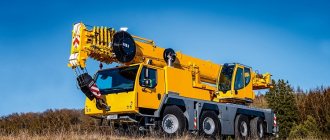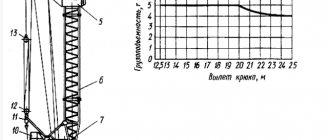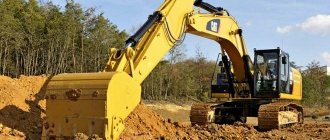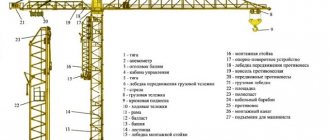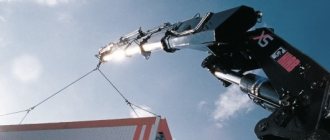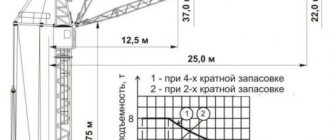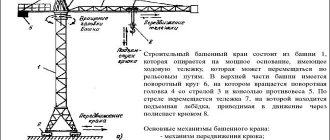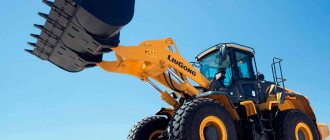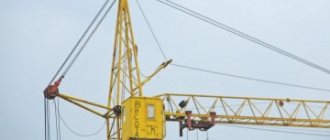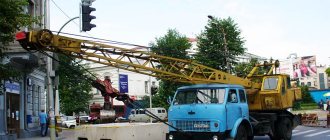The boom of a truck crane is its main working part. It is she who performs operations related to lifting and moving cargo. How does a truck crane lift the boom? How does a truck crane carry a load? What modifications of arrows are there? How does a tower crane assemble itself? We will answer these and other questions in the article below.
In what situations is a truck crane boom used to lift loads?
Truck cranes are widely used in a wide variety of areas of construction, utilities, and manufacturing. Depending on the design features, the truck crane is capable of performing the following operations:
- working with heavy and bulky loads;
- lifting loads in urban environments;
- moving cargo in hard-to-reach places;
- lifting loads in places with difficult terrain.
There are several modifications into which the arrows are divided, depending on the operating conditions. To solve the assigned tasks, a truck crane is selected according to its technical characteristics. The load capacity indicator depends on the operational features.
Benefits of working with us
- Wide range of products - 25 thousand items.
- Factory quality control.
- Prompt delivery times (from 1 day) by any method convenient for the buyer throughout Russia and the world.
- Individual and flexible approach to each client.
You can clarify prices, delivery conditions for any spare parts, as well as sections of KS booms, by contacting our manager by phone: 8 (800) 555-74-74
!
We try to make maximum discounts for each client. In the special section “Promotions” you can get up-to-date information on current discounts on spare parts. Delivery to any region of Russia and the CIS by transport companies convenient for you: Ekaterinburg, Tyumen, Irkutsk, Novosibirsk, Ufa, Irkutsk, Astana/Kazakhstan.
Any questions? Call!
How a truck crane lifts a boom: mechanism of operation
Mobile cranes, such as the one shown in the picture, can extend their telescopic boom, which is operated hydraulically. Due to this, they are able to easily lift multi-ton loads on it.
By removing the movable part of the boom inside, such a truck crane becomes comparable in size to a regular truck. The truck crane lifts the booms using a winch mechanism controlled by a cable that is lowered from the boom. The load is attached to this cable using a hook.
How a truck crane lifts a boom - winch mechanism
When the winch begins to wind the cable, the load rises. A system of multiple pulleys and cables between the hook and boom reduces the effort required to operate the winch.
How a crane lifts a heavy load without tipping over: the rule of leverage
When the crane lifts heavy loads on the boom, it rests on cantilever beams or stabilizers - this is necessary to prevent the truck crane from overturning. Each such beam acts as a fulcrum for a lever scale. With its help, the lifted load is balanced by the weight of the truck crane itself. The extendable legs of the support beam are made of steel, aluminum or nylon. Each leg can be raised and lowered individually until the crane is in the desired position. This allows you to find a stable position even on uneven ground.
How a truck crane lifts a boom: a visual diagram
The mechanism of how a truck crane lifts the boom is based on the operation of hydraulic cylinders. Two hydraulic cylinders control the movement of the boom. One cylinder is responsible for raising and lowering, and the second is responsible for lengthening and shortening.
Preview
Classification of truck cranes
The classification of truck cranes is based on three main parameters. These are the load capacity, suspension of the working mechanism and design features of the drive. And the choice of a truck crane depends on what kind of lifting work is ahead. In the event that the power of the truck crane cannot cope with the load, work must be suspended.
Truck crane device
A truck crane is a self-propelled vehicle on a vehicle chassis, designed for various lifting operations. The installation is equipped with a rotating platform. The crane may include a grab, dragline, palletizer, and the like. Booms can be truss (non-retractable) or retractable with a rectangular closed section. Less common are cranked arrows. A lattice extension - a jib - is made to order for the arrows.
The main function of a truck crane is to move loads and install structures and technical equipment. Truck crane services can be provided by qualified specialists who already have experience working on construction sites. The first question to be answered is what the mass of the load will be. Compare the assigned tasks with the vehicle’s cargo-height characteristics. Incorrect counting may affect the performance and condition of the truck crane.
Most modern truck cranes have a built-in microprocessor load limiter, which records information about the height of the boom, the load on the truck crane, the boom reach and length, and the maximum load capacity in given conditions.
Types of truck cranes
The following types of cranes can perform lifting operations:
- tractor cranes that operate on the basis of a tractor;
- crawler cranes operating on crawler tracks;
- on wheels;
- on rails;
- on an automobile-type chassis;
- So-called self-propelled cranes move independently.
Self-propelled cranes are equipped with a special all-terrain vehicle running device. Easily overcoming off-road conditions, such machines are capable of moving just as quickly on the highway (up to 60 km/h or more). Unlike machines on standard vehicle chassis, this type of truck crane does not have an intermediate supporting frame.
A truck crane on a truck chassis can reach high travel speeds. This allows you to use it simultaneously in several areas remote from each other.
Pneumatic wheel cranes are equipped with a running device - a chassis with axles with rigid suspension (one or two of them are driving). Can reach speeds of up to 20 km/h.
Only crawler cranes are slower than them - only a few kilometers in an hour. But thanks to the tracked bogies, they are distinguished by high cross-country ability. This type of truck cranes can perform lifting operations and move with loads even on unpaved ground.
Classification by load capacity
The Russian market offers cranes with a lifting capacity from 10 to 250 tons. Based on the lifting capacity, truck cranes are divided into eight groups.
- heavy-duty cranes. This includes cars from groups six to eight. Intermediate lifting capacity on ropes reaches from 40 to 250 tons;
- middle class: these include truck cranes of groups 3, 4 and 5 (lifting operations with a weight of 30 to 60 tons);
- small class is, respectively, 1 and 2 size groups with an intermediate weight on ropes from 4 to 8 tons.
Classification by boom suspension type
The boom is the working mechanism of a truck crane. There are several types of this device.
- rigid, which is used with a hydraulic cylinder;
- flexible, steel cable is used.
Classification by type of drive power supply
Here the division can be said to be standard:
- electric;
- hydraulic;
- mechanical.
Types of truck crane booms
Most modern models of truck cranes are equipped with telescopic booms. The boom mechanism consists of several retractable sections. This retractable design can support significant weight and is also highly flexible. If we consider domestic models of truck cranes, then their maximum number of retractable sections is 5.
A Russian-made truck crane can have a maximum of 5 sections.
If a larger structure is required, it is more rational and convenient to use a mobile crane with a tower boom. It differs from the telescopic design by its higher lifting height. Tower cranes are used in the construction of high structures.
Tower jib truck cranes
Tower jib cranes, also (according to the Liebherr classification) called self-propelled construction cranes, are used in the construction of multi-storey buildings to handle various loads. For example, for the delivery of materials and blocks from the place of their unloading to the site of their installation.
Tower jib truck cranes are equipped with a lattice telescopic boom, consisting of several modules. When unfolded, it takes on an L-shape. Part of the boom – the “tower” – rises up either strictly vertically or at a slight angle. The second part is located in the horizontal plane.
Image source liebherr.com
The lifting mechanism in such cranes can be implemented in two ways. The first involves fixing the winch at the base of the tower and transmitting the movement by a block-cable mechanism. This option increases the reliability of the design. However, it is not very practical. The second option involves mounting the winch on the boom. The load-carrying capacity and reliability of the structure in this case decreases, but practicality increases.
Image source liebherr.com
An example of such a solution is the Liebherr MK 140 mobile construction crane. It also demonstrates the limitations of the design. Despite the fact that this is a flagship model, the crane’s lifting capacity at maximum boom reach is only 1.9 tons. But such a load can be lifted to a height of up to 40 meters.
How a truck crane carries a load
The truck crane in the working position is ready to carry cargo.
Lifting booms of truck cranes during operation can move the load:
- vertically,
- horizontally.
The reach of the tower boom is regulated by moving the truck crane itself. To increase it, it is necessary to stop the operation of the crane, and during the working day this can happen several times, which is very inconvenient. Therefore, in the vast majority of situations, truck cranes with a telescopic boom are used. The main advantage of how a truck crane lifts a boom is its versatility. The ability to carry cargo in several planes at once increases the range of work performed.
Options
Parameters are the basic quantities that characterize the crane. The main parameters of jib cranes are:
Tilt and rotate
For jib slewing cranes, it must be possible to lift the largest working load on the design slope in all positions of the rotary part.
The calculated angle of inclination is an angle whose value is:
When working on outriggers for jib cranes, the tilt angle can be 1° 30″. The design angle of inclination with tower-boom equipment is determined by the design organization and is indicated in the crane's passport (in the USSR it was introduced by the information and directive letter of the USSR State Mining and Technical Supervision of August 26, 1971).
Structural features of the boom of a truck crane
Each crane boom assembly has its own functional features. The lifting capacity of the boom depends on the number of sections.
How does the lifting capacity of a truck crane depend on the number of sections?
For a telescopic boom with a lifting capacity of 10 tons, 2 sections are enough. In the future, as the load capacity increases, it is necessary to add sections.
Cross-section of a truck crane boom
If you look at the cross-section of the boom of a truck crane, you can see that it has a rectangular shape. This gives an advantage during assembly. There are also ovoid-section booms for truck cranes (a real breakthrough in production), trapezoidal and multi-faceted sections, which are equipped with additional clamps. Thus, the cross section of a truck crane boom can be:
- rectangle,
- ovoid,
- trapezoid,
- polyhedron.
The ovoid profile has improved the technical characteristics of the arrows. The main advantages include:
- high level of sustainability,
- large margin of safety,
- resistance to high power loads,
- low metal consumption.
Booms of ovoid section effectively withstand all types of loads, and today they are successfully introduced into the production of jib cranes.
Truck cranes
A truck crane is a jib-type crane that can be equipped with tower-jib equipment and moves without a load, without requiring special paths and whose stability is ensured by gravity.
Working equipment, parts, assemblies and details of automobile cranes
Truck crane drive
Technical characteristics of truck cranes
Chassis and supporting structure of truck cranes
Application of truck cranes
Explanation of the designation of jib self-propelled cranes
Manufacturers (brands) of truck cranes
Ivanovets16 tons crane KS-35714 crane KS-35714K-2 crane KS-35714K-2-10 crane KS-35714K-3 crane KS-3571525 tons crane KS-45717-2R AIR crane KS-45717-1 crane KS-45717-1R crane KS-45717-2 crane KS-45717 -2Rkran KS-45717A-1Rkran KS-45717A-1Rkran KS-45717K-1Rkran KS-45717K-1Rkran KS-45717K-3kran KS-45717K-3Rkran KS-5574435 tonscrane KS-55735-6crane KS-55735-740 tons crane KS-65740 -6 crane KS-65740-7 crane KS-65740-8 Chelyabinets16 tons crane KS-45734-19-0525 tons crane KS-45721-21 crane KS-55732-21 crane KS-55732-2832 tons crane KS-55732-33 crane KS-55733-26 crane KS-55733 -3340 tons crane KS-65711-3450 tons crane KS-65717-34Galichanin25 tons crane KS-55713-1 crane KS-55713-3 crane KS-55713-5 crane KS-55713-1Lcrane KS-55713-3Lcrane KS-55713-5Lcrane KS-55 713-1Vkran KS-55713-3Vkran KS-55713-3V NEXTkran KS-55713-4Vkran KS-55713-5Vkran KS-55713-1V-4kran KS-55713-5V-4kran KS-55731-4kran KS-55713-632 tons (OVOID)crane KS-55729-1V-3 crane KS-55729-5V-3 crane KS-55729-1V crane KS-55729-5V50 tons (OVOID) crane KS-65713-1 crane KS-65713-5KS-65715KS-65715-160 tons (OVOID) crane KS-65721 crane KS-65721-2 crane KS-65721-670 tons (OVOID) crane KS-75721 crane KS-75721-1 crane KS-75721-2100 tons (OVALOID) crane KS-84713-6 crane KS-84713-2 crane KS-85713 Klintsy 16 tons faucet KS-35719-1-02 crane KS-35719-3-02 crane KS-35719-5-02 crane KS-35719-7-02 crane KS-35719-8 crane KS-45719-3 crane KS-45719-7 crane KS-45719-8K25 ton crane KS -55713-1K-1kran KS-55713-3K-1kran KS-55713-5K-1kran KS-55713-6K-1kran KS-55713-1K-2kran KS-55713-3K-2kran KS-55713-6K-2kran KS- 55713-1K-3kran KS-55713-3K-3kran KS-55713-5K-3kran KS-55713-6K-3kran KS-55713-1K-4kran KS-55713-3K-4kran KS-55713-5K-4kran KS-55713 -6K-4kran KS-55713-1K-4Vkran KS-55713-3K-4Vkran KS-55713-4K-4Vkran KS-55713-5K-4Vkran KS-55713-6K-4Vkran KS-55713-12K-4V27 ton crane KS-55713 -1K-1Vkran KS-55713-5K-1V40 tons crane KS-65719-1Krane KS-65719-3Krane KS-65719-3K-1kran KS-65719-5Krane KS-65719-7KKATO automobile crane KATO KR25H-Vkran KATO KR50H-Vkran KA TO NK1000faucet KATO NK-550VRKomatsukomatsu lw250 5Zoomlionzoomlion qy25vzoomlion qy30vzoomlion qy50vzoomlion rt55XCMGxcmg qy25k5xcmg qy30kxcmg qy50kxcmg qy70kxcmg qy100kLiebherrliebherr ltm 1050liebherr ltm 1100liebherr ltm 1200liebherr ltm 1055liebherr ltm 1090liebherr ltm 1160liebherr ltm 1500liebherr ltm 1250liebherr ltm 1030liebherr ltm 11200liebherr ltm 1 060liebherr ltm 1070liebherr ltm 1120liebherr ltm 1040liebherr ltm 1300liebherr ltm 1150liebherr ltm 1080liebherr ltm 1350liebherr ltm 1750liebherr ltm 1220liebherr ltm 1130liebherr ltm 1400Grovegrove gmk 5220grove gmk 4080grove gmk 5130grove gmk 3055grove gmk 4100grove gmk 5100grove gmk 63 00lgrove gmk 3050grove gmk 2035Kruppkrupp kmk 4050krupp kmk 6250krupp kmk 6140krupp kmk 7250krupp kmk 2025krupp kmk 4070krupp kmk 3045TAKRAFTadanoLokomo
How a tower crane assembles itself
Tower cranes are used in the construction of multi-story buildings. The tower itself acts as a support, and the horizontally directed beak directly carries out the main function.
Lattice cranes have a number of installation difficulties, however, compared to telescopic cranes, they have a greater load capacity.
How does a tower crane lift itself? Using hydraulic pistons. The section of the tower crane located under the cabin is thicker than the others. When you need to assemble, this section, due to hydraulic pistons, “grows” to the height of one segment. At this time, the crane lifts one segment and places it in the space created after lifting the cabin on hydraulic supports. The simplicity of the way a tower crane lifts itself allows the process to be repeated as many times as needed to assemble very tall structures.
How the tower crane assembles itself is shown in the photo below.
How a tower crane assembles itself - step 1
How a tower crane is assembled - step 2
Truck crane control cabin code
Stationary | code
The stationary control cabin of the truck crane must be located within the dimensions both in width and height. As a rule, it is equipped with a protective grille to protect against falling objects from the construction site, a sliding door for ease of opening, and panoramic glazing for maximum visibility for the crane operator.
Non-fixed tower cabin | code
The non-fixed cabin is divided into 2 types, which can be combined with each other. The first type of such cabin has a hydraulic lifting mechanism to change the angle of inclination to improve the crane operator's upward visibility. The second type is a necessary measure so that the cabin can be folded into the dimensions in driving mode. This cabin is sometimes called a “turning” cabin. When switching from working to driving mode, the cabin rotates 180* using hydraulics and ends up behind the counterweight.
RESULTS ¸Ñном ÑодÑ. RESULTS Ñми ÑкÑплÑаÑаÑии. Ð ÑкÑпедиÑиÑÑ, пÑи оÑÑÑÑÑÑвии доÑог, в ÑÑÑдно RESULTS, ASSURANCE, RESULTS RESULTS н на гÑÑениÑном ÑодÑ. RESULTS: RESULTS: µÐ½Ð½ÐµÐµ, мобилÑнее, не Ñак давÑÑ Ð½Ð° гÑÑнÑ.
RESULTS, ROOM, ROOM ROOM › Ñном Ñдалении дÑÑг Ð¾Ñ Ð´ÑÑга. RESULTS Ñве, пÑокладке неÑÑе- и газопÑоводов, ÑÑÑа RESULTS и.
Â
How a truck crane holds a load
Various parts are used to hold the load during lifting:
- cylinders,
- clamps,
- extension cords,
- geese.
A jib is an extension that is used to increase the lifting capacity of a truck crane. In this case, there is no need to resort to more complex and massive equipment. Using hinges, it is attached directly to the boom. The structure itself has 2 hooks - the main one and the auxiliary one.
One of the design options for the main hook on a truck crane
Technical characteristics of the boom of a truck crane
All arrows differ in their technical features, which must be taken into account when selecting a modification:
- Knowing the reach and lift, you can calculate the lift height of the hook;
- Load capacity determines the maximum load, including the weight of the hook and other mechanisms;
- Departure time is the time period during which the arrow moves in the opposite direction.
Mobile crane slewing ring
The slewing support device of the truck crane is fixed on the lower platform and performs the following tasks:
- connects the rotary block to the stationary platform;
- takes over and distributes the load during operation of the crane installation, increasing stability and preventing overturning;
- ensures easy rotation of the rotating frame around a vertical axis.
A ball slewing device in the form of a bearing is assembled from cages (external and internal) with 2 rows of balls between them. The outer ring of a pair of rings (lower and upper) is screwed to the rotating frame. The inner one, which has teeth, is screwed to the stationary platform. If the ring gear is located on the outer race, then it is the ring that is attached to the running frame.
The roller slewing ring is a set of 3 rings with rollers between them. The internal one is attached to the lower part of the car (running frame) and is equipped with a ring gear with which the turning gear is in contact. The outer rings are bolted together and connected to the crane's turntable. This design ensures uniform load distribution and has a greater load capacity than a ball design.
In addition to the features of the slewing support, the design of the main working tool of special equipment is of interest - the boom, a popular type of which is the telescopic model.
What does a telescopic boom consist of?
The telescopic boom of a truck crane consists of the following components:
- grounds,
- retractable sections (hydraulic cylinders and pulleys, sliding plates, stops and linings),
- mechanism for changing length,
- fixing devices.
The sections of the sliding sections operate under different types of loads:
- the upper part is in tension;
- lower – for compression;
- side parts - for bending.
Previously, we wrote about the technical characteristics, features, typical breakdowns, preparation for work and maintenance of the KS-3575 truck crane.
Providing truck crane services: when is it profitable to rent equipment, how to conclude an agreement
What types of burners are there: by fuel type, gas, by application, for boilers
Screw screw conveyors for bulk materials: device, characteristics, types of spiral conveyors
Metal cable trays: advantages, types, which ones to choose
Truck tire rating: for drive and steering axles, for semi-trailer with characteristics in the table
Renting a front loader with or without a driver: which is more profitable?
Which trailer is better - single-axle or two-axle: which one is more convenient, which one is better to choose for a car or truck
Caterpillars for special equipment: what advantages do they have over wheeled vehicles?
How to choose tires for special equipment: choose the right one
Diagnostics of Common Rail diesel injectors: types, faults, repairs
Productivity of jaw crushers: what it depends on, calculation formula
Railway crane
A railway crane on rails is a fully rotating, self-propelled mechanism on railway rails. The devices are used for loading work in warehouses of reinforced concrete panels, unloading blocks at a construction site, and installation during the construction of industrial buildings.
In order to be able to service warehouses for bulk materials, railway devices are often supplemented with a grab.
The railway unit consists of:
- rotating platform;
- high-tech boom;
- durable frame;
- reliable power unit;
- mechanism systems;
- driver's cabin;
- rotary support system;
- worker node.
Modern rail-mounted cranes with a lifting capacity of less than 15 tons are used without outriggers. Units that lift loads exceeding 15 tons operate on supports. The units can perform the following functions:
- lifting load;
- rotation of the unit;
- movement of the device with a load;
- change in boom radius.
Rail-mounted jib cranes can move independently or be attached to railway trains.
Laying crane UK-25 9-18
The UK-25/9-18 laying crane is used for assembling and dismantling railways with rails weighing up to 18 tons, length up to 25 m when laying or repairing railway tracks.
The tracklayer UK-25/9-18 has the following technical characteristics:
- Traction force - 100 kN.
- Diesel power is 121 kW.
- Track width - 1435, 1520 mm.
- The lifting capacity of the unit is 18 tons, the platform is 40 tons.
- The length of the railway link is 25 m.
- Speed - 80 km/h (during transportation), 20 km/h (self-propelled).
- Dimensions: 43330x6820 mm.
- Weight - 102 tons.
Laying crane UK-25 25
The UK-25/25 track-laying crane has a high lifting capacity and is equipped with a telescopic rotary truss. The unit has the ability to telescopically rotate the boom. The mechanism is used for the installation of railway tracks. It can lay links 25 m long and weighing 25 tons. The unit is self-propelled. When performing work, it is the main machine of track-laying complexes.
Why then crawler cranes?
If there is a technique with the same purpose, but of a different design, then each of the designs has its own pros and cons. It is easier and cheaper to transport a wheeled crane to a construction site (even taking into account administrative restrictions), but as soon as the machine takes its starting position for work, it is immediately deprived of mobility. The fact is that wheel axles are not designed to withstand the loads experienced by a crane working with a heavy load. In addition, the wheeled crane has a high base and, accordingly, a high center of gravity. To give the machine greater stability, and at the same time protect the chassis from damage, the crane is placed on outriggers and slightly raised above the platform. Once installed on the outriggers, the crane will be able to work only within the departure zone, that is, move loads where the boom can reach. A crawler crane has no such restrictions. It has a wider and lower base, weight ballast is already built into it, and it does not require outriggers. A crawler crane can move around a construction site along with its load, which is why such cranes are much more often purchased for a long term rather than rented.
When folded, the telescopic boom resembles a ballistic missile.
Methods of carrying cargo
In lifting booms, the load is transferred simultaneously horizontally and vertically by increasing or decreasing the angle of inclination. Due to the design features, cranes with similar modifications are much lighter than other types.
The rigid boom type is characterized by a constant reach length during the operating cycle. The load is moved by the movement of the crane itself, as well as by the rotation of the lifting mechanism. To increase the reach, it is necessary to stop the operation of the truck crane.
In models with a cargo trolley, it moves horizontally. If it is necessary to increase the lifting height, the boom is placed in an inclined position, and a cargo trolley is attached to its end.
https://youtube.com/watch?v=2p5jBk1amRk
Telescopic models
With the expansion of the scope of use of self-propelled jib cranes, their working mechanisms began to improve. If the first models were equipped with lattice modifications with cable suspension, today truck cranes are equipped with telescopic booms. Their movable design allows not only to increase the load capacity of the truck crane, but also to move freely along the highway in the flow of ordinary cars.
Lattice models had a simple design; their production did not require complex technological operations. To lengthen it, special inserts were used, which required additional time and effort. With the advent of telescopic booms on hydraulic cylinders, a real revolution took place in the production of boom truck cranes.
